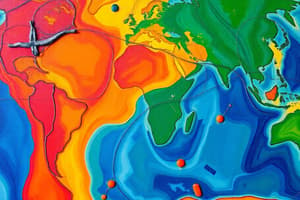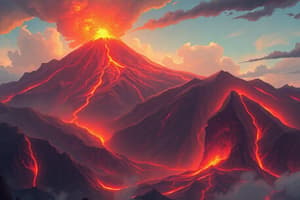Podcast
Questions and Answers
What is the primary cause of earthquakes?
What is the primary cause of earthquakes?
- Liquefaction in soil
- The collision of tectonic plates (correct)
- Landslides triggered by seismic activities
- Volcanic eruptions
Which tectonic plate movement can lead to earthquakes?
Which tectonic plate movement can lead to earthquakes?
- Plates colliding and forming mountains
- Plates moving past each other (correct)
- Plates sliding parallel to each other
- Plates moving away from each other
What is the primary association of volcanic activity in relation to tectonic plate margins?
What is the primary association of volcanic activity in relation to tectonic plate margins?
- Associated with subduction zones
- Associated with transform plate margins
- Associated with convergent plate margins (correct)
- Associated with divergent plate margins
How are tsunamis typically generated?
How are tsunamis typically generated?
What is the primary cause of liquefaction in soil during earthquakes?
What is the primary cause of liquefaction in soil during earthquakes?
What type of movements can trigger landslides?
What type of movements can trigger landslides?
What scale is used to measure the magnitude of volcanic eruptions?
What scale is used to measure the magnitude of volcanic eruptions?
How are earthquakes monitored?
How are earthquakes monitored?
What method determines physical damage caused by earthquakes?
What method determines physical damage caused by earthquakes?
Which of the following is crucial for predicting and preparing for potential tectonic hazards?
Which of the following is crucial for predicting and preparing for potential tectonic hazards?
What effects can tectonic hazards have on ecosystems?
What effects can tectonic hazards have on ecosystems?
How does early warning systems aid in reducing the impact of tectonic hazards?
How does early warning systems aid in reducing the impact of tectonic hazards?
Flashcards are hidden until you start studying
Study Notes
Tectonic hazards are natural events that occur due to the movement of the Earth's crust, specifically the movement of tectonic plates. These hazards include earthquakes, volcanic activity, and their secondary effects such as tsunamis, landslides, and liquefaction.
Earthquakes are caused by the sudden release of energy in the Earth's crust, typically at the boundaries between tectonic plates. For example, the North American and Pacific plates are moving past each other, leading to earthquakes in the region. Convergent plate margins, where two continental crusts collide and buckle, like the Eurasian and Indian plates, have formed the Himalayas.
Volcanic activity, on the other hand, is primarily associated with convergent plate margins, where two plates are colliding and pushing magma up from the Earth's interior. This can lead to volcanic eruptions and the formation of volcanoes.
Secondary hazards caused by earthquakes include tsunamis, liquefaction, and landslides. Tsunamis are caused by vertical displacement of the seabed, which then displaces the water in the ocean water column. Liquefaction can develop in soil due to earthquakes, causing the ground to lose its strength, which can damage buildings and infrastructure. Landslides are the movements of rock, earth, or debris down a slope, which can be triggered by earthquakes.
Tectonic hazards can also lead to natural disasters, which occur when the natural hazard has caused significant damage to society or a community, and they can no longer cope using their own resources. This can include disruptions to human, material, or environmental aspects, such as loss of life, injuries, and damage to infrastructure. Examples of such disasters include the Gorkha Earthquake, Tohoku Earthquake and Tsunami, and Mount Merapi Eruption in 2010.
Monitoring tectonic hazards is crucial for predicting and preparing for potential hazards. Earthquakes are monitored using seismographs and the moment magnitude scale (MMS), while the magnitude of volcanic eruptions is measured using the Volcanic Explosivity Index (VEI). Other observable methods include the Mercalli scale, which determines physical damage, and studying groundwater levels, release of radon gas, and unusual animal behavior for short-term prediction.
While prevention is not always possible for tectonic hazards, early warning systems and preparedness can greatly reduce their impact. This includes earthquake-resistant building design, understanding hazard zones, and intensive studies along fault lines.
Tectonic hazards have significant effects on human life and infrastructure, causing loss of life, damage to buildings, and environmental impacts. They can also alter landscapes and ecosystems, leading to long-term recovery efforts. Continued research and technological advancements are essential for improving our understanding, monitoring, and response to tectonic hazards.
Studying That Suits You
Use AI to generate personalized quizzes and flashcards to suit your learning preferences.




